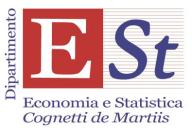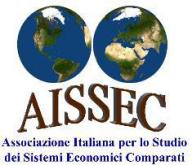28 | FEBRUARY 2025
Introduction
By Iacopo Maria Taddei[1]
The OEET, in collaboration with the Collegio Carlo Alberto (CCA) and the Department of Economics and Statistics Cognetti de Martiis, held its 10th Workshop on November 28–29, 2024, at the University of Turin. Titled 10 Years of the Turin Centre on Emerging Economies: Lessons Learned and Perspectives for the Future, the event marked a decade since the centre’s founding.
The Workshop featured three thematic sessions on OEET’s core research areas: economic development and inequality, sustainable development and the 2030 Agenda, and emerging economies in global value chains (GVCs). This issue of the OEET newsletter compiles contributions from these discussions, highlighting the challenges faced by emerging economies in fostering inclusive, sustainable growth along with a progressive accumulation of domestic productive capabilities through a strategic insertion into global value chains (GVCs). It also examines the influence of developed countries' policies on these trajectories.
By Hans Timmer[1]
Acemoglu, Johnson, and Robinson have been awarded the 2024 Nobel Prize in Economic Sciences for their studies of how institutions are formed and affect prosperity. They have developed evidence that exploitive institutions are inadequate for long-run growth, while inclusive ones are good for it. This evidence fits a broader cross-country literature that argues that economies thrive when the rule of law guarantees equal opportunities.
These critical results shed light on key puzzles in development economics: Why is per-capita income in the most developed countries 100 times the per-capita income in the least developed countries? Are poorer countries prone to catch up with more affluent countries, or are they likely to fall further behind? The Nobel laureates conclude that income gaps might widen further because of strong inertia in the development of institutions. This research leads to a welcome focus in economics on institutions.
By Olga Demidova [1]
The aim of this study is to examine the dynamics of income inequality across Russian regions over the past 11 years (2013–2023). To measure inequality, we use the Gini coefficient and the decile ratio (10/10 ratio). The analysis reveals substantial variation in inequality levels across regions, with the Gini index ranging from 0.32 to 0.49 and the decile ratio from 7.9 to 26.9. However, these indicators show limited variation over time. Overall, the level of inequality in Russia is relatively high. Nonetheless, between 2013 and 2023, there has been a general downward trend in inequality both at the national level and across most regions. For instance, Russia's Gini coefficient decreased from 0.417 in 2013 to 0.406 in 2020, further declining to 0.398 in 2022 before slightly increasing to 0.405 in 2023.
The first key question explored in this study is whether there is a relationship between the level of economic well-being in Russian regions and their respective levels of inequality. According to Kuznets’ hypothesis, as economic development progresses, inequality initially rises until a certain threshold is reached, after which it begins to decline — suggesting an inverted U-shaped relationship between income inequality and economic development. To investigate whether Russian regions have followed this pattern, panel fixed-effects models were estimated.
By Maurizio Bussolo[1]
Some Recent Influential Work on Inequality
Economic inequality, defined as the unequal distribution of income and wealth among individuals and groups within a society, has been a persistent issue throughout history. In the recent decade, the study of economic inequality has gained renewed importance as economists and policymakers recognize its far-reaching implications for social and economic progress. This note explores the evolving perspectives on economic inequality over the past decade and examines potential developments for the next decade.
In the early 21st century, economic inequality was often viewed through the lens of market efficiency and individual responsibility. Traditional economic theories emphasized the role of free markets in promoting growth and prosperity, with less attention given to distributional outcomes. Over the past decade, there has been a significant shift towards inclusive growth, recognizing that high levels of inequality can undermine economic stability and social cohesion. Prominent studies include Joseph Stiglitz's "The Price of Inequality" (2012), Thomas Piketty's "Capital in the Twenty-First Century" (2014), Angus Deaton's "The Great Escape" (2013), Anthony Atkinson's "Inequality: What Can Be Done?" (2015), Branko Milanovic's "Global Inequality: A New Approach for the Age of Globalization" (2016), Emmanuel Saez and Gabriel Zucman's "The Triumph of Injustice" (2019), and Raj Chetty's papers on intergenerational mobility. These studies have profoundly shaped the understanding of economic inequality, highlighting its complex nature and the need for comprehensive, long-term solutions.
By Piergiuseppe Fortunato[1]
The outcome of COP29 has been disappointing. At stake in Baku was the money needed to help poor countries shift to a low-carbon economy and adapt their infrastructure to the impacts of extreme weather. About $1.3tn a year will be needed by 2035 for countries to achieve this, and for the world to stay within the 1.5C limit. A deal on how to get some way to reaching that target was struck in that hall, but it was one so hedged, loose and half-hearted that many cried betrayal.
Only $300bn of the promised total will come directly from the budgets of developed countries and public finance institutions, such as the World Bank. The great majority of that money should be in the form of grants and low-interest loans, but loose wording means even that commitment is hedged – the cash could come from “a wide variety of sources, public and private, bilateral and multilateral and alternative sources”.
This stalemate reflects the perversity of the challenge ahead of us. Only changing the existing narrative and aiming at a process of socio-economic transformation socially ‘desirable’ for a great majority of the world population would pave the way for an energy transition on the scale we need.
By Sara Balestri and Marcello Signorelli[1]
Deforestation and forest degradation[2] are driven by multiple factors, including population growth (leading to a higher global demand for food and feed), demand for bioenergy products and trade of timber and timber-related commodities (FAO, 2020). An estimated 420 million ha of forest has been lost worldwide through deforestation since 1990. Although the annual global rate of forest loss has decreased substantially (FAO, 2023), large heterogeneous patterns can be identified at the regional level: while Asian countries have performed remarkably well with a net positive change in forest cover over the past three decades, South America and Sub-Saharan Africa have lagged behind. However, different trends can also be traced here: while in Latin America the rate of deforestation, although still high in absolute terms, is slowing down over time, in Africa the net loss of forests is increasing.
Within this scenario, the Sustainable Development Goals Framework (namely, the SDG 15 – Life on Land) includes forests among the terrestrial ecosystems whose conservation, restoration and sustainable use have to be ensured by 2020 (target 15.1) and commits towards promoting sustainable management of all types of forests, halting deforestation, restoring degraded forests and substantially increasing afforestation and reforestation globally by 2020 (Target 15.2). Notwithstanding, global forest area continues to decline, primarily due to agricultural expansion, despite notable progress in sustainable forest management and such targets are unlikely to be met even extending the timeframe to 2030. Urgent action is imperative, especially in the Global South where the enforcement of sustainable forest management systems is more problematic.
By Luca Andriani, Panagiota Makrychoriti, and Emmanouil G. Pyrgiotakis[1]
Reducing carbon emissions is a global challenge, with corporate CO2 emissions being a major contributor to climate change (Hossain et al., 2023). Firms face growing pressure from stakeholders, including banks, customers, investors, and regulators (Kacperczyk and Peydró, 2022; Deng et al., 2023; Azar et al., 2021; Bartram et al., 2022), to adopt pro-climate strategies. However, the limitations of international regulations (Homroy, 2023) necessitate the integration of cultural and social values into corporate decision-making.
Social capital, defined as shared trust, values, and networks that foster cooperative behaviour (Guiso et al., 2011), may drive such strategies by encouraging long-term, community-oriented decisions (Putnam, 1993; Fukuyama, 1995). This forward-looking, community-oriented ethos can encourage firms and decision-makers to prioritize sustainability, making social capital a potential catalyst for climate cooperation. Despite its well-established economic benefits (Knack and Keefer, 1997), the role of social capital in corporate climate behaviour remains underexplored.
By Samuele Milone[1]
Introduction
Rural communities in developing countries face unique challenges when climate shocks disrupt their livelihoods. In Thailand, where rice cultivation underpins both the economy and food security, droughts have wide-reaching implications. This essay summarises findings from a study investigating how drought affects children’s education in rural Thailand, focusing on enrolment and grade delay, while highlighting the vulnerabilities of agricultural households.
Data and Methodology
This study draws on the Thailand Vietnam Socio-Economic Panel (TVSEP), a dataset encompassing nine waves of household and village surveys conducted from 2007 to 2022. The sample comprises over 3,000 individuals and more than 8,000 observations across 220 villages in 45 districts. Drought exposure was identified through self-reported shocks experienced in the previous year, while a dummy variable for agricultural households was constructed based on rice production. Households producing less than 25% of rice for personal consumption were categorised as market oriented.
To analyse the effects of drought on educational outcomes, a multilevel regression model was employed, with individuals nested within villages. Random intercepts at the village level accounted for unobserved heterogeneity, and standard errors were clustered at the district level. Three model specifications progressively introduced control variables, including household size, parental education, and village characteristics, to isolate drought’s impact and its interactions with household agricultural dependence.
By Alessia A. Amighini[1]
Global Value Chains (GVC) have been massively shaped by participation of emerging economies. Emerging economies’ participation in GVC is one of the most outstanding developments in the global economy since the mid-1990s. Until the 1980s, North-North trade dominated global trade flows. Then, South-North trade and South-South trade have risen sharply.
The People’s Republic of China (PRC) is clearly at the centre of this trade growth: its share of global exports increased sixfold in the span of 40 years (now 14% of global, making it the world's top exporter). Besides China, other countries benefited from the massive relocation of production activities from the North: most notably, Vietnam, Malaysia and Thailand in Southeast Asia, Slovakia, Hungary, Czech Republic and Bulgaria in Eastern Europe, Tunisia and Morocco in North Africa. These countries engaged mostly in so-called backward participation, i.e. the share of foreign value added in their exports. Overall, the North’s declining share of global exports, down from 80% in 1991 to 60% in 2018, mirrors the South’s share of global exports up from 20% to 40% over the same period. This trend faced a significant halt in 2018, when a withdrawal from free trade started in the United States, with the introduction of tariffs on imports from China. This contributed to reduce not only US imports from China, but also the ability of other countries to continue exporting, being engaged in China-led regional value chains, as in the case of Malaysia.
By Chahir Zaki[1]
Introduction
Environmental concerns are becoming more and more important in today's globalized world. This topic becomes even more relevant with the increasing participation of developing countries into global value chains (GVC) that represent almost 70% of the current trade flows. Since environmental conservation is essential to halting climate change, it is crucial to understand the bidirectional relationship between Global Value Chains (GVCs) and climate change on the one hand; and GVC and the environment on the other, which makes the analysis rather complicated.
How GVC affect climate change and the environment?
GVC has an effect on carbon emissions and the environment via several channels. First, the technique and competition effects refer to the case where green technologies and eco-friendly products benefit the environment and enhance its quality (but not in early-stage participation in GVC) (Wang et al., 2019). Second, GVC can affect the environment through international transport related to trade that is linked to increases in carbon emissions (OECD, 2017). Transport pollution is higher in GVC compared to standard trade since product crosses borders many times. Finally, according to the Pollution Heaven Hypothesis, multinational firms operate in countries with lenient environmental laws in order to avoid costly environmental requirements, making these countries pollution heavens (Ben David et al., 2020). Bazillier et al. (2024) show that forward GVC participation increases carbon emissions and has an environmental downgrading effect. However, this effect is attenuated by the number of laws related to the environment and to the existence of environmental provisions that are legally enforceable.
By Giovanni Graziani[1]
The scope of the study is to measure the process of decoupling between the US and China as it appears in trade and foreign direct investments (FDI) flows through various pieces of evidence: official data on international trade and FDI, the behaviour and intentions of the firms involved as they show up from surveys, databases from various institutions, case studies and anecdotical evidence. The analysis spans through the period 2017-2023, with glimpses on the first eight months of 2024.
Through the appropriate indicators I try to quantify the supply-switching and export re-orientation taking place on both sides of the Pacific. As a whole, import dependency and export reliance show a decline for both contenders (that is, some decoupling is taking place). On the import side, if we look at commodity groups at a very high level of aggregation, we find that US import dependency on China has fallen in most of the 97 HS sectors at the 2-digit level. However, if we dig at a more disaggregated level, from the 4-digit to the 10-digit level, the picture appears to be more complex. Decoupling is not occurring uniformly but varies according to the different products. China lost market shares in all products hit by 25% US tariffs, and in many other products, either hit with lower tariffs or not hit with tariffs at all. But it does not materialize for many products not targeted by US protectionist policies, which even show an increase of dependency.
Our activities
-
11th OEET Workshop Programme
Global Trade Shocks and Geopolitical Uncertainty: Implications for Food Security in Emerging...









